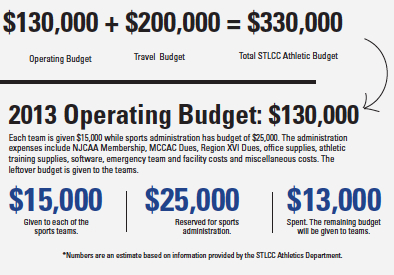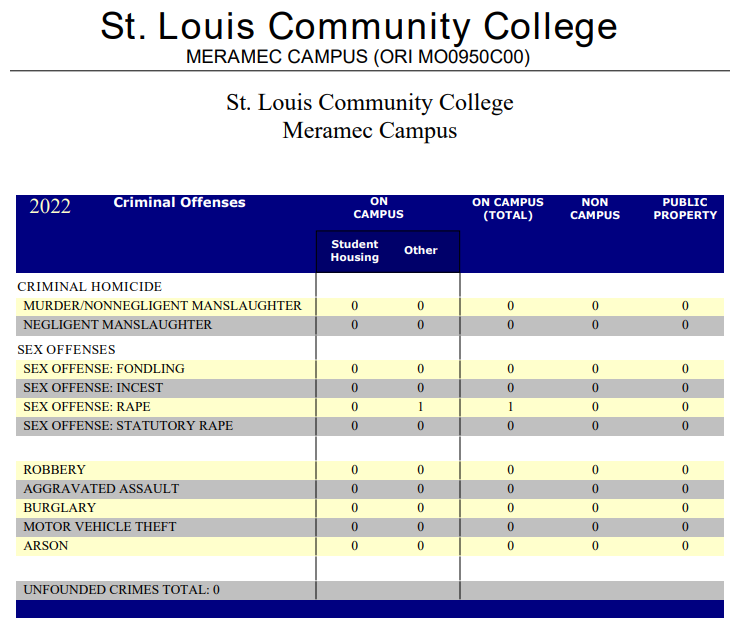A look at how the money is spent
 By: SPENCER GLEASON
By: SPENCER GLEASON
Editor in Chief
As STLCC braces for potential cuts in state aid and drops in enrollment for the 2014-15 academic year, programs, department events and student activities may be at risk without adequate funding.
STLCC receives money from state aid, property taxes and student tuition and fees. When property taxes are reduced, state aid is reduced and enrollment is down, the college feels the effects, Acting Vice President of Student Affairs Kim Fitzgerald said.
“Simple economics say if your income goes down that in order to meet your budget you have to cut your expenses. If your income goes up, the\n you can spend whatever you want,” Fitzgerald said. “But what we’re looking at is, ‘Okay, how do you cut some of the spending? If you cut this, how do you still maintain good services, programs, course offerings and all of that?’”
Although STLCC departments, activities and programs have faced budget cuts over the years, elements of the budget for Archer athletics have been retained since the consolidation of sports in 2011.
For district-wide athletics, STLCC allocates $330,000 per year. That number is then divvied up into two separate accounts, per team — an operating budget and travel budget.
In 2013, the operating budget was $130,000, which was separated equally among the seven teams for replacing ripped uniforms, equipment, field maintenance, game officials and the everyday operating expenses for each team. For travel, the athletic department received $200,000.
“When we were in transition [in July 2011], we were given a dollar amount,” Co-Athletic Director Johnna Kinney said. “Within that dollar amount, we didn’t get to decide, ‘This sport gets that much and this sport gets that much.’ We were told each sport gets ‘this amount.’”
According to Co-Athletic Director Sharon Marquardt, in each of the Archers’ seasons — 2011, 2012 and 2013 — because the budget amounts do not rollover to next season, each team spent their operating budget down to zero, each year.
“Everybody has spent their allotted amount. We spend our operating budget down to zero,” Marquardt said. “It doesn’t rollover. Coaches do extremely well spending it literally down to the penny. If they do have money left over, they’ll buy a new uniform or whatever, so that’s not on next year’s budget.”
Marquardt, who oversees the Archers’ budget, while Kinney focuses more on NJCAA rules and regulations for the athletics department, said that the money for the operating budget is designated from upper administration, whereas the travel budget comes from student fees.
“The operating budget is the budget that downtown established for us. I’m assuming when they billed the district budget for the year, that’s built in there. That’s what we get annually,” Marquardt said. “Some of that travel fund comes from some of the student fees that are paid for student activities. I know that’s within the big budget of our district; there’s no revenue coming over to feed that. It’s just within the district.”
According to Steve Brady, manager of Campus Life at Meramec, the amount that each campus’ student activities fund sets aside for athletic travel is decided by the number of credit hours of enrollment at each institution (STLCC-Meramec, STLCC-Forest Park, STLCC-Florissant Valley and STLCC-Wildwood). That money is put toward each team’s meals, hotels and transportation for away games.
At Meramec, during the 2015 fiscal year, it is projected $84,640 of the $246,117 that student activities will put toward campus based funds will be allocated for athletic travel. Brady said during a March 25 Student Governance Council (SGC) meeting that STLCC-Florissant Valley, STLCC-Forest Park and STLCC-Wildwood would pay $49,040, $53,380 and $12,940 respectively.
“We’re mandated by Board Policy to pay for athletic travel,” Brady said at the meeting. “STLCC takes the number of credit hours that are generated and it says, ‘This percent is generated by the Meramec campus.’ In this case, it’s 42.32 percent. So our share comes to about $84,000. We have no control over that.”
Although student activities are allowed to fundraise and student fees support athletic travel, the athletic department is not allowed to fundraise.
“We, as an athletic department, do not do concessions because we are not allowed to fundraise. We don’t have a place to take any revenue of any type,” Marquardt said. “When the transition came down, it was a decision that was made by upper administration at the time. I don’t know the exact reason why we can’t fundraise. I don’t know the answer to that.”
How the Money is Spent
Prior to each season, the coaches of each team plan out their schedule. They choose what trips and games that they play.
While traveling out of town, coaches for all seven teams, Kinney (women’s volleyball), Marquardt (softball), Scott Goodrich (baseball), Juergen Huettner (women’s soccer), Dan O’Keefe (men’s soccer), Randy Reed (men’s basketball) and Shelly Ethridge (women’s basketball) are given their own athletic procurement card.
Marquardt said that those procurement cards are only used for food and hotel.
“When they make those transactions, they have a non-local expense report that they have to fill out,” Marquardt said. “They have to fill it out for each day that they’re gone. Then they attach the original receipts to that expense report.”
From there, according to Marquardt, the expense reports follow a paper trail checks and balances line that begins with the athletic department’s secretary. Then they are sent to Kinney and Marquardt, followed by the Director of District Wide Athletics and Meramec President Pam McIntyre and finally they are sent to the Cosand Center downtown, where they are looked over again.
“Then it’s allocated to a budget, which would be our operating budget,” Marquardt said.
Before the consolidation in 2011, Marquardt said that athletics was losing money every year. But now that they are three years into the Archers’ athletics, they are starting to see athletics stay afloat.
“The initial couple of years, from my standpoint, didn’t show any financial advantage,” Marquardt said. “But now that we’re in it, you can see that from the administrative side, they were doing what was best for our district. So far, it’s paid off.”












